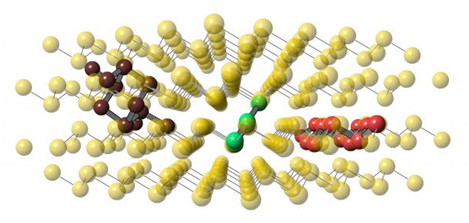The original Carnegie Science press release can be read here.
New work from a team of researchers using high pressure and temperature at the U.S. Department of Energy’s Advanced Photon Source (APS) revealed a kind of “structural memory” in samples of the metal bismuth, a discovery with great electrical engineering potential. Their findings were elucidated in an article in the Proceedings of the National Academy of Sciences U.S.A.
Bismuth is a historically interesting element for scientists, as a number of important discoveries in the metal physics world were made while studying it, including important observations about the effect of magnetic fields on electrical conductivity.
Bismuth has a number of phases. A chemical phase is a distinctive configuration of the molecules that make up a substance. Water freezing into ice or boiling into steam are examples of how changes in external conditions can induce a transition from one phase to another. But for physicists and materials scientists, application of extreme pressures and temperatures can bring about a large variety of other phases. For example, under increasing pressure and temperature conditions bismuth undergoes an array of phase transitions, including eight different types of solid phases observed so far.
In previous studies of bismuth, pressure-induced structural changes were not retained when the pressure was reduced. However, the research team—which included colleagues from the Carnegie Institution of Washington, Yanshan University (China), and The University of Chicago—used a pathway of successive pressure and temperature conditions at the High Pressure Collaborative Access Team (HP-CAT) 16-BM-B at the APS to create a form of bismuth that has a “structural memory” of a previous phase. The APS is an Office of Science user facility at Argonne National Laboratory.
When bismuth is brought to a liquid state under between 14,000 and 24,000 times normal atmospheric pressure (1.4 to 2.4 gigapascals) and at about 1,800 degrees Fahrenheit (1,250 kelvin), and is then slowly cooled back to a solid state, the solid “remembers” some of the structural motifs of its liquid predecessor.
“The high-pressure liquid becomes more structurally disordered when the heat is applied, taking on what we call a ‘deep liquid’ state, certain structural characteristics of which remain even when the bismuth is cooled back to solid,” article co-author Guoyin Shen of Carnegie and Director of HP-CAT explained. “This is the first time such an effect has been seen in an elemental metal.”
Fascinatingly, this “memory” is correlated with a shift from being repelled by a magnetic field to being attracted to a magnetic field. The team believes it will be possible to induce a similar shift in physical properties in other, similar, elements, including cerium, antimony, plutonium, and others.
See: Yu Shu, Dongli Yu, Wentao Hu, Yanbin Wang*, Guoyin Shen**, Yoshio Kono, Bo Xu, Julong He, Zhongyuan Liu, and Yongjun Tian, “Deep melting reveals liquid structural memory and anomalous ferromagnetism in bismuth,” Proc. Natl. Acad. Sci. 114(13), 3375 (March 28, 2017). DOI: 10.1073/pnas.1615874114
Correspondence: *wang@cars.uchicago.edu, **gshen@carnegiescience.edu
Financial support was provided by the National Natural Science Foundations of China Grants 51421091, 51332005, and 51025103 and Ministry of Science and Technology of China Grant 2011CB808205. Y.W. acknowledges support from the U.S. National Science Foundation (NSF) Grants EAR-1214376, 1361276, and 1620548. G.S. and Y.K. acknowledge the support of the U.S. Department of Energy (DOE) Office of Science-Basic Energy Sciences, Division of Materials Science and Engineering Award DE-FG02-99ER45775. High Pressure Collaborative Access Team operations are supported by U.S. DOE-National Nuclear Security Administration Award DE-NA0001974, with partial instrumentation funding by the NSF. This research used resources of the Advanced Photon Source, a U.S. DOE Office of Science User Facility operated for the DOE Office of Science by Argonne National Laboratory under Contract No. DE-AC02- 06CH11357.
Argonne National Laboratory seeks solutions to pressing national problems in science and technology. The nation's first national laboratory, Argonne conducts leading-edge basic and applied scientific research in virtually every scientific discipline. Argonne researchers work closely with researchers from hundreds of companies, universities, and federal, state and municipal agencies to help them solve their specific problems, advance America's scientific leadership and prepare the nation for a better future. With employees from more than 60 nations, Argonne is managed by UChicago Argonne, LLC for the U.S. Department of Energy's Office of Science.
The U.S. Department of Energy's Office of Science is the single largest supporter of basic research in the physical sciences in the United States and is working to address some of the most pressing challenges of our time. For more information, visit the Office of Science website.

